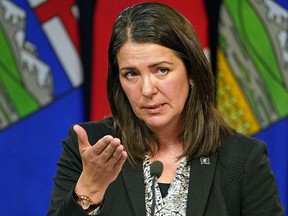David Pugliese, Ottawa Citizen - TODAY
Canada’s military leadership is pushing for industry and the federal government’s procurement system to go to a war-time footing so more weapons can be supplied to Ukraine.

Chief of Defence Staff Gen. Wayne Eyre has been pushing for companies to switch to what he is calling a “war footing” so weapons production can be ramped up both for Ukraine and to replenish Canadian military stocks.© Provided by Ottawa Citizen
National Defence and top firms that produce arms, such as Lockheed Martin, are financing a conference in Ottawa on Oct. 25 titled “Putting Canadian Defence Procurement on a War Footing.”
Top defence officials, including Chief of the Defence Staff Gen. Wayne Eyre and assistant deputy minister for procurement Troy Crosby, will be key speakers at the event.
Eyre has been pushing for companies to switch to what he is calling a “war footing” so weapons production can be ramped up both for Ukraine and to replenish Canadian military stocks.
Eyre has argued that the war between Ukraine and Russia should be the catalyst for such a major shift in defence industrial capacity. “I think what this has shown, though, is we need to increase the capacity of defence industry,” Eyre told CBC in May. “Given the deteriorating world situation, we need the defence industry to go into a wartime footing and increase their production lines to be able to support the requirements that are out there, whether it’s ammunition, artillery, rockets … you name it. There’s a huge demand out there.”
NATO nations, including Canada, have donated billions of dollars in weapons and equipment to Ukraine.
But Alan Williams, a former assistant deputy minister for procurement at National Defence, said industry wouldn’t ramp up production unless it received contracts from the federal government.
Defence firms, he noted, don’t build equipment out of the goodness of their hearts. “They are in it for profit,” Williams said. “They have shareholders to satisfy. They want contracts … Their attitude is, ‘If you want equipment, then sign those contracts.’”
That view was echoed by defence firm representatives at a major conference and trade show last week in Washington. “I think the first thing we need is orders,” Thomas Laliberty, a senior official with Raytheon Missiles and Defence, told the conference. “We need insight into the demand, and, once we understand the insight into the demand and we understand the willingness of the government to pay for additional capacity, that then helps us go plan for what it will take for us to actually increase production.”
Some defence industry officials have privately noted Eyre doesn’t seem to understand industry can’t ramp up its production without government contracts in hand since building sophisticated weaponry requires upfront purchasing of supplies and material.
But Eyre’s office responded to this newspaper that, “The CDS has both a sense of what is required to replenish the draw-down of CAF stocks, as well as our ability to continue supporting Ukraine with the items they are most in need of. The CDS advice was provided in the context of what those items are and the need for industry to surge for the level of support to Ukraine to remain sustainable.”
Williams pointed out there was already an existing process to purchase equipment on an urgent basis. That process was used during the Afghan war to acquire howitzers and drones as well as armoured vehicles. But using that process is a decision that has to be made by elected officials, not generals or bureaucrats, he noted. “Before one acts, one has to get the marching orders from government,” Williams said.
Using such a process will also require Canadian procurement staff to be rigorous in their oversight to ensure firms don’t rip off taxpayers, Williams added.
The Liberal government has not made any announcement that firms need to go onto a war footing or that military procurement process would use the urgent acquisition process.
National Defence has provided $50,000 to finance the Oct. 25 conference hosted by Canadian Global Affairs Institute, a think-tank closely aligned with the Canadian Forces and the defence industry. Other sponsors include Lockheed Martin, General Dynamics, Irving Shipbuilding, Davie Shipyard; ATCO Frontec, BAE Systems Canada and General Atomics. National Defence also confirmed there were no set costs for commands on what they could spend to send military personnel to the conference, including paying for travel to Ottawa.
Defence insiders have said they hope the conference will highlight the need for the Liberal government to buy more weapons for both Ukraine and the Canadian military.
Williams said there were limits on what Canadian firms could do. Canada does produce ammunition and small arms as well as armoured vehicles and drone cameras, but many other weapons are purchased from U.S. and European firms.
For instance, in May, Canada announced it was buying 20,000 artillery rounds to donate to Ukraine, but those had to come from the U.S..
Canada has provided Ukraine with armoured vehicles, small arms, anti-tank systems and drone cameras. The latest donation involves winter uniforms.
Ramping up defence production for more sophisticated weapons, however, could face hurdles. Many modern weapons are highly reliant on sophisticated electronics and other components now in high demand. The pandemic has also created issues with supply chains and the availability of workers. Lockheed Martin, for instance, has noted it will boost Javelin anti-tank missile production, but that could take as long as two years because of supply-chain problems.
A report earlier this year from the U.S. Department of Defense noted shortages of skilled labour in America’s defence industry. In addition, China has dominated the market for the production of microelectronics as well as castings and forgings, both critical for weapons production.
Eyre recently stated China was at war with western nations, including Canada.







